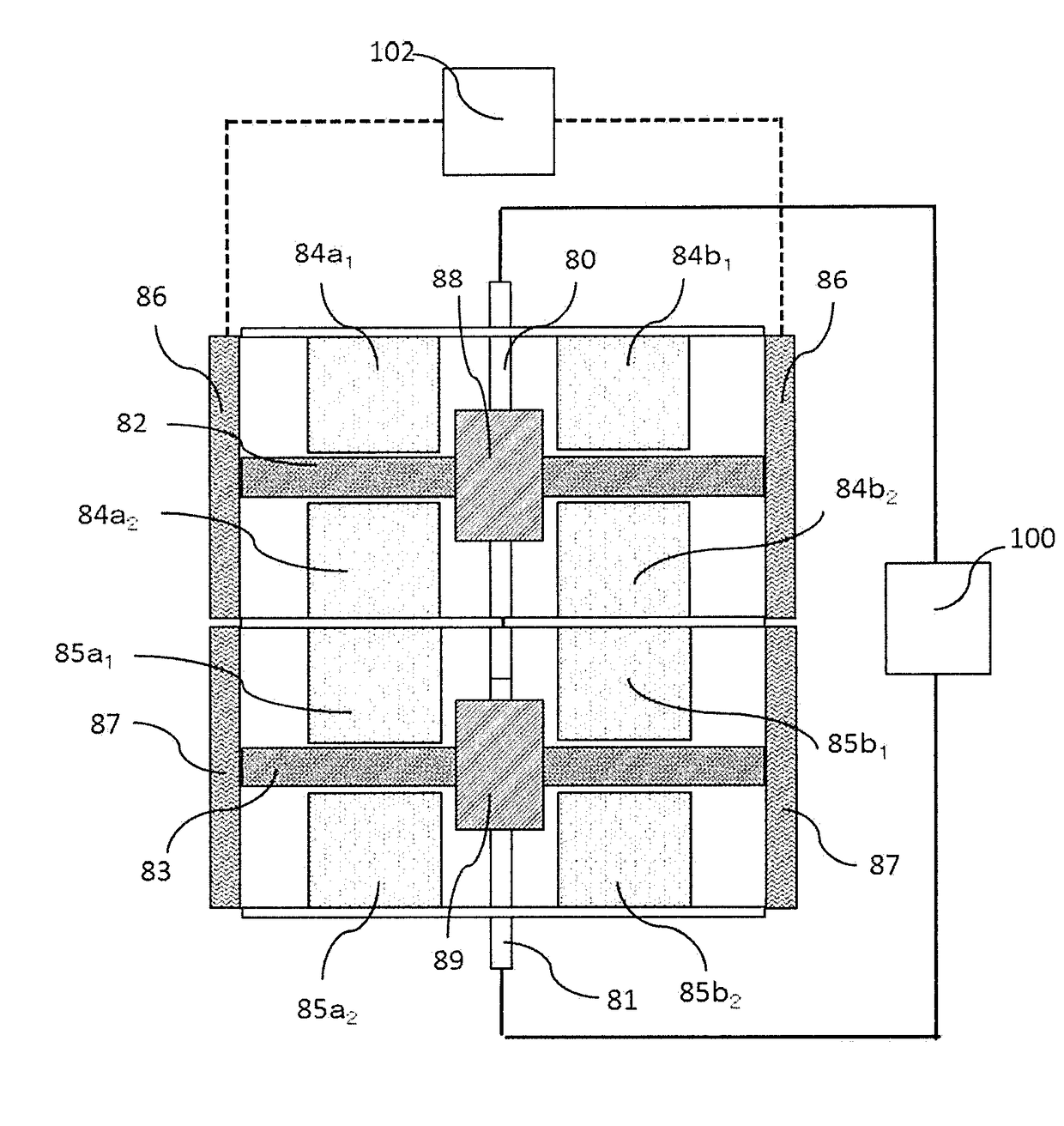Magnetic refrigerating device
a technology of magnetic refrigerating device and magnetic field, which is applied in the direction of refrigerating machine, lighting and heating apparatus, machines using electric/magnetic effects, etc., can solve the problems of heat loss and hinder the increase of the frequency of the refrigeration cycle, and achieve the effect of increasing the cycle ra
- Summary
- Abstract
- Description
- Claims
- Application Information
AI Technical Summary
Benefits of technology
Problems solved by technology
Method used
Image
Examples
second embodiment
[0065]FIG. 5 is a structural diagram of the invention, showing the main structure of a device in which two horizontally opposed-type AMRs are combined. FIG. 5 shows a magnetic refrigerating device in which the horizontally opposed-type two-cylinder AMRs, which are the same as in FIG. 1 but out of phase, are combined.
[0066]In FIG. 5, AMR beds 50A and 50B each have two magnetic materials joined by a magnetic material reciprocating unit, such as a spring, and its inner structure is similar to FIG. 1 and thus is omitted in the drawing. The AMR bed 50A, which is depicted in a horizontal state in FIG. 5, is in a position overlapping permanent magnets 54a and 54b. The AMR bed 50B, which is disposed in a position intersecting the AMR bed 50A, is away from the permanent magnets 54a and 54b. The rotary shaft 55 is provided along the rotation axis of a pair of circular plates (not shown in the drawing) on which the AMR beds 50A and 50B and the magnets 54a and 54b are mounted.
[0067]Since a magn...
third embodiment
[0068]FIG. 6 is a structural diagram of the invention, showing the main structure in which four horizontally opposed-type AMRs are combined. FIG. 6, (A) is a plan view, and FIG. 6, (B) is a cross-sectional view along line A-A in FIG. 6, (A). Here, four horizontally opposed-type AMRs are combined and cold heat is further transported from low-temperature-side heat exchangers for the AMRs to coolers 68 and 70. In addition, hot heat is further transported from high-temperature-side heat exchangers for the AMRs to heat outlets 69 and 72. Rotary shaft central portions 65 and 68 of the AMRs are common components for convenience of heat exchange and drive. When viewed from the rotary shaft central portions of the AMRs, eight single-cylinder AMRs look like hub and spokes. Note that the arrow indicates the direction of the rotation of the AMR bed.
[0069]In FIG. 6, AMR beds 60A, 60B, 60C, and 60D each includes two magnetic materials joined by a magnetic material reciprocating unit, such as a sp...
fourth embodiment
[0074]FIG. 8 is a structural diagram of the invention, showing the main structure of a device in which two horizontally opposed-type AMRs are stacked. In FIG. 8, AMR beds 82 and 83 each include two magnetic materials joined by a magnetic material reciprocating unit, such as a spring, and their inner structures are similar to FIG. 4 and thus are omitted in the drawing. Low-temperature-side heat exchangers 88 and 89 are provided in the central portions, and high-temperature-side heat exchangers 86 and 87 are provided at both ends.
[0075]The AMR bed 82, which is depicted upward in FIG. 8, is in a position overlapping permanent magnet 84a1, 84a2, 84b1, and 84b2. The AMR bed 83, which is disposed lower than the AMR bed 82, are away from the permanent magnets 85a1, 85a2, 85b1, and 85b2. Rotary shafts 80 and 81 are provided along the rotation axis of a pair of circular plates (not shown in the drawing) on which the AMR beds 82 and 83 or the permanent magnets 84a1, 84a2, 84b1, 84b2, 85a1, 85...
PUM
 Login to View More
Login to View More Abstract
Description
Claims
Application Information
 Login to View More
Login to View More - R&D
- Intellectual Property
- Life Sciences
- Materials
- Tech Scout
- Unparalleled Data Quality
- Higher Quality Content
- 60% Fewer Hallucinations
Browse by: Latest US Patents, China's latest patents, Technical Efficacy Thesaurus, Application Domain, Technology Topic, Popular Technical Reports.
© 2025 PatSnap. All rights reserved.Legal|Privacy policy|Modern Slavery Act Transparency Statement|Sitemap|About US| Contact US: help@patsnap.com



